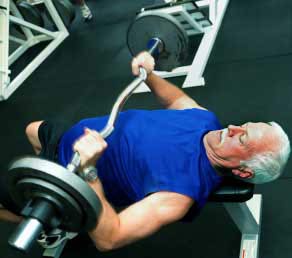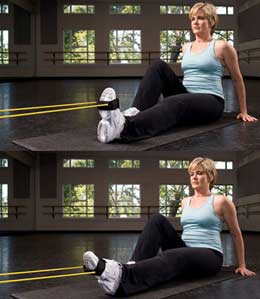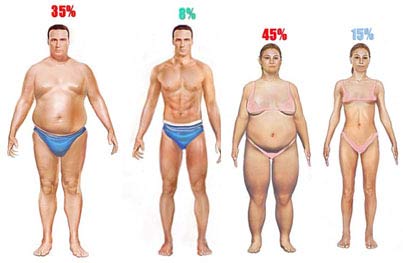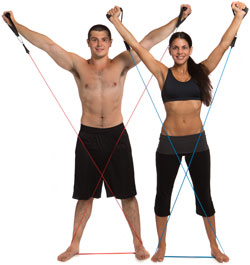- Like
- SHARE
- Digg
- Del
- Tumblr
- VKontakte
- Flattr
- Buffer
- Love This
- Save
- Odnoklassniki
- Meneame
- Blogger
- Amazon
- Yahoo Mail
- Gmail
- AOL
- Newsvine
- HackerNews
- Evernote
- MySpace
- Mail.ru
- Viadeo
- Line
- Comments
- Yummly
- SMS
- Viber
- Telegram
- JOIN
- Skype
- Facebook Messenger
- Kakao
- LiveJournal
- Yammer
- Edgar
- Fintel
- Mix
- Instapaper
- Copy Link
 Three Essential Components of Physical Fitness
Three Essential Components of Physical Fitness
The three components of physical fitness are strength, endurance and flexibility. Most exercise and fitness programs combine these three elements. It is important to incorporate these three elements in your exercise program to achieve a healthy and energetic lifestyle.
Strength
Strength can be gained through two types of training, resistance and weight. Weight training is a form of training where the force of gravity in the form of dumbbells and weighted bars is used to oppose the force generated by the muscle via eccentric and concentric contraction. In resistance training, hydraulic and elastic tension is used to provide the actual resistance.
There has been a different (and in my opinion a more effective) way to train, especially if you are short on time. This training method is cardio strength training. Without getting into too much detail on this very effective course of training, I can suggest a great book, “Cardio Strength” by Robert Dos Remedios. This is an amazing book and worth every penny. In my opinion, any serious trainer should have this book. Study it and apply some of the examples given. This book took my training to a whole new level and took me to a level of conditioning I didn’t think was possible.
Endurance
Endurance training consists of performing low- to medium-intensity exercise for an extended period of time. This type of training can be done by running or jogging, and using equipment like the stair stepper or elliptical machine.
Endurance training is different from other forms of physical stress, where fatigue of the muscles and cardiovascular system would cause one to stop a particular exercise. In endurance training, these conditions would not cause the physical output or effort to end.
The experts at London Fitness – In Home Personal Training state that endurance training improves your aerobic and anaerobic fitness simultaneously, meaning all energy systems are made stronger.
James at FitnessAbout says, “By adding endurance training, the performance for training other components of your fitness is maximized.”
There are a quite a few confusions and misconceptions when it comes to endurance training. Let me touch on a couple to help you better understand the three components of physical fitness.
- If you are training for a long distance event, say a marathon, should you skip on the high intensity training, and save your energy for your long distance training? NO!!! You need to work on your legs since they play a great part in running, and also don’t forget to work on your core.
- If you want to lose weight, should you run or bike on empty? NO!!! Your body will perform like it is dying with no fuel. Don’t eat donuts. Go for protein and complex carbs. If you’re always on the move (like me!), stash a few packs of protein-rich biltong jerky in your bag. This is my current go-to protein when I hit up the trails on my bike.
Flexibility
Flexibility is the range of movement in a joint or series of joints and muscles that is attainable through your own efforts, the help of a partner, or a piece of equipment. There are many advantages to being physically flexible. Flexibility improves general health, reduces the chances of injury, and improves your physical performance.
The most common form of stretching is known as static stretching. This is refers to the practice of stretching to your maximum capacity, holding for a brief period of time, and then releasing. Static stretching helps improve circulation and prepares your joints and muscles for your next workout. Regardless of what type of exercise you are doing, incorporating flexibility training can further your progress and enhance your health, movement and balance. Flexibility should become a natural part of your routine.
Three Components of Physical Fitness: Final Thoughts
A training plan or regime that combines all three of these elements is the ideal fitness plan. Many avid gym rats will bypass flexibility training and focus mainly on strength and endurance. If you observe these rats in their training habits, eventually you will find one limping, walking with one hand pressed to the side of their backs, or stretching a shoulder that has been injured due to the lack of stretching in the first place. All three are important; they complement each other. If your goal is to have optimal health and fitness, then start with these three elements (along with a healthy diet) and you will be well on your way.
5 Components of Physical Fitness
Why These Five Components of Physical Fitness Are Important

Remember High School P.E. Class?
If you have searched for the five components of physical fitness and are now reading this article, there is a good chance that you first heard about the five basic components of physical fitness many years ago.
Your parents and teachers told you to get off the couch, out of the house, and exercise because it’s good for you. Exercise is indeed good for you, but in order to get the most out of exercising, you should follow a balanced exercise program. That is where the five components of physical fitness come in.
What is the Definition of Physical Fitness?
There is no easy answer to that question. Physical fitness means something different for everyone. If you want to find a definition that works for almost everyone, you should visit the Definition of Physical Fitness.
An Effective Long-Term Exercise Program is a Balanced Exercise Program
The following five aspects of physical fitness are each very important to your health, because if you have all five components covered through a balanced exercise program, you are likely to stay healthier, be happier, and live longer.
You can look at the five components of physical fitness as markers of true fitness. You are only as strong as your weakest link, and if you are weak in any of the following five areas, you should work at them to become a more balanced, physically fit person.
#1. Cardiovascular Endurance

What is Cardiovascular Endurance?
Cardiovascular exercise, also called cardiopulmonary exercise, or simply cardio, consists of aerobic physical activities lasting longer than 90 seconds.
To better understand the terminology, you should know that cardio- refers to the “heart”, vascular means related to blood vessels, and pulmonary means related to the lungs.
Cardiovascular or cardiopulmonary endurance is your physical ability to maintain aerobic exercise for prolonged periods of time.
Physiologically, cardiovascular endurance refers to the efficiency of your heart, lungs and vascular system’s delivery of oxygen-rich blood to your working muscles during activities that last longer than 90 seconds.
Why is Cardiovascular Endurance Important?
Cardiovascular endurance is very important because the more fit your cardiovascular systems becomes, the healthier your lungs, heart and vascular system will be.
If you demonstrate high levels of cardiovascular endurance during exercise, you also have a more efficient heart, lungs, and vascular system while at rest.
This means less stress is put on your heart and lungs around the clock, enabling you to avoid illness and live a long, healthy life. Many argue that cardiovascular endurance is the most important of the 5 components to physical fitness.
#2. Muscular Strength

What is Muscular Strength?
Muscular strength is the amount of force your muscles can exert against resistance for short duration, anaerobic (without oxygen) activities. Resistance includes external objects such as free weights or household objects, or even own body weight during bodyweight exercises.
Physiologically, muscular strength it is the ability of your cells to supply muscle energy in the form of ATP (adenosine triphosphate) to your muscle fibers for concentric, eccentric and isometric contractions in time frames ranging from 0 to around 15 seconds.
Why is Muscular Strength Important?
The primary reason why muscular strength is important is its effect on activities of daily living (ADLs). Efficiency and safety during ADLs are two of the most important reasons for becoming proficient in all 5 components of physical fitness. The best way to build fitness for performing ADLs is through functional training, or exercises that mimic the activities you do in daily life or your sport of choice.
At the very least, to be physically fit in the muscular strength department, you should demonstrate the basic muscular strength needed to efficiently your ADLs. While ADLs vary from person to person, you can also consider activities such as push-ups, pull-ups, and carrying heavy objects to be ADLs.
Each of the 5 components of fitness depends on the others. Poor muscular strength can negatively affect aerobic fitness and muscular endurance.
#3. Muscular Endurance

What is Muscular Endurance?
While muscular strength deals with short duration muscle contractions, muscle endurance deals with sustained muscle contractions and other anaerobic activities lasting less than 90 seconds.
Why is Muscular Endurance Important?
Muscular endurance is the bridge between muscular strength and cardiovascular endurance. In order to be have a fit cardiovascular system, you must demonstrate muscular endurance.
While muscle strength deals primarily with fast-twitch type II muscle fibers, muscular endurance deals with primarily slow-twitch type I muscle fibers. Your body contains both types of fibers, but only anaerobic exercises which last longer than around 15 seconds and less than 90 seconds strengthen your type I muscle fibers.
- Sets and Reps
Learn all about how your resistance training workouts can improve each of the 5 components of physical fitness through different exercise selection, sets, reps, weight training volume and weight training splits.
#4. Flexibility / Mobility

What is Flexibility?
Flexibility is the range of motion possible for each of your joints or groups of joints.
Why is Flexibility Important?
To some degree, your flexibility determines the efficiency of your muscles. Increased flexibility has also been associated with decreased risk of acute and chronic (overuse) injuries.
Poor flexibility can directly affect cardiovascular endurance, muscle strength, and muscular endurance. Physiologically, flexibility can include extramuscular factors, such as range of motion at a joint, as well as intramuscular factors, such as hypertonicity (knots) within the muscles themselves.
- Cumulative Injury Cycle
Learn all about the Cumulative Injury Cycle including how and why flexibility training prevents injury.
#5. Body Composition

What is Body Composition?
Body composition is the percentage of your body’s tissues which are composed of fat versus tissues which are fat-free.
The easiest and most common way to look at body composition is with a two-compartment analysis which compares the amount of body fat you have with your lean body mass, which includes muscle, bone, water, and organs.
It takes expensive equipment for a three-compartment analysis which isolates bone mass, which can also be considered an important part of body composition.
Why is Body Composition Important?
You could say body composition depends on the other components of physical fitness. Focusing on the other four aspects of physical fitness will naturally lead to improved body composition over time.
Having a poor body composition has many negative physical and psychological effects, such as increased chance of chronic diseases and depression. As mentioned previously, improper exercise habits and poor lifestyle choices can not only lead to being overweight or obese, but decreased bone mass associated with osteopenia and osteoporosis.
Body Fat Measurement
If you want to know if you are physically fit according to the 5 components of physical fitness, you should learn about the cheap and effective ways to estimate your body composition.
If you think your scale weight is too high, you may want to estimate your lean body mass as well as fat mass. Scale weight alone does not accurately reflect the more important metric of body composition.
From body composition data you can find out how much fat you should lose to accomplish your weight loss goals while sparing your lean mass. Check out this Fat Loss 101 article if you are new to fat loss.
Which of the 5 Basic Components of Fitness is the Most Important?
You Are Only as Physically Fit as Your Weakest Link
You cannot rank one of the health-related components of physical fitness as more important than the others, as all 5 components of physical fitness are interdependent upon each other.
Finding which of the 5 components is most important for you to focus on is as simple as identifying your weakest link. If you are very strong but cannot jog a mile without getting out of breath, you need to focus more on your aerobic exercise. If you are very lean and have high cardiovascular fitness but you cannot touch your toes, you need to work on your flexibility, and so on.
Now That You Know the 5 Components of Physical Fitness, it’s Time to Start or Improve your Exercise Program
- Best Cardio Machines
You can possibly improve 3 of the 5 components of physical fitness on any cardio machine, provided you work hard enough. Learn tips that will help you operate the cardio machines properly to get maximum cardiovascular benefits.
See Also:
About Michael Behnken
Mike Behnken is a personal trainer who holds multiple NASM certifications and a MS in Exercise Science. Mike loves fitness, travel, and photography among many other interests.

